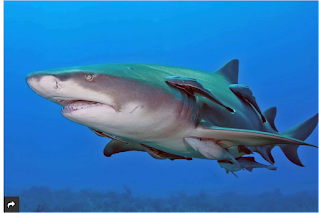Lemon Shark: Some Body Characteristics, Habitat And Customs
The body characteristics, habitat and customs of the lemon shark are known to most researchers.
This is because the species has the ability to survive in captivity for a long time, allowing scientists to observe its behavior.
 |
| Lemon Shark: Some Body Characteristics, Habitat And Customs |
This feature is rare, as few sharks can be kept in captivity.
In this way, follow us and learn even more information about the species, its distribution, curiosity, feeding and reproduction.
Classification:
- Scientific name – Negaprion brevirostris;
- Family – Carcharhinidae.
Features of the Lemon Shark
An interesting feature about the Lemon Shark would be the group life.
When individuals live together they develop communication, predatory behavior and also protection, something that we will cover in more detail in the topic of “curiosities”.
So, know that the species was listed in the year 1868 and has pointy and small teeth.
This species also has a tail like a whale shark.
In this way, the color would be responsible for the common name, varying between yellow and brown.
Fish have a second dorsal fin and stay in shallow places.
In addition, sandy bottoms in lagoons are also good places to see the animal, such as bays and river mouths.
It is also worth mentioning that the fish are active at night and some studies indicate that this species does not migrate.
The animal’s behavior is shy when it is around divers, but it can become aggressive if it feels threatened.
Lastly, this type of shark is about 3 m in total length.
Reproduction of the Lemon Shark
About the reproduction of the lemon shark, we can mention several information such as the following:
It is common for individuals of the species to come together to mate in specific locations.
Therefore, fertilization would be internal and, like other species, males bite females very violently.
They have the ability to store sperm in a gland over the course of months and the reproductive cycle occurs every two years.
In this sense, it is important for you to know that nutrition occurs through a placenta originated by the interaction between the wall of the female reproductive tract and the yolk sac of the embryo.
Regions such as mangroves or places with shallow water would be ideal for females to give birth.
The cubs are born at 75 cm in length and are independent. Without the mother or father needing to protect them from predators, so they stay in shallow water.
These waters serve as a kind of nursery, in which several cubs stay until they are able to migrate to the deeper waters.
In view of this, know that individuals are mature from 12 to 16 years of age and fertility would have a low rate.
As a result, females are believed to have a maximum of 18 offspring.
Food
First of all, know that the Lemon Shark is carnivorous and would be more selective.
This means that individuals hunt medium-sized prey such as bony fish and cartilaginous fish.
They can also eat molluscs, crustaceans and when young, sharks are cannibals.
The feeding period occurs during the night because the sharks take advantage of the victims swimming slowly.
Thus, the main strategy would be to approach the victim at high speed and brake suddenly, using the pectoral fins.
With this, the shark advances forward in order to capture the prey with its jaw.
Finally, it shakes its head from side to side until it manages to remove a piece of prey.
Curiosities
The first curiosity is that on the snout and head, the Lemon Shark has Lorenzini ampoules, which would be special sensory organs.
The sensors are made up of a network of channels with electro-receptors that are covered in a gelatinous substance.
Thus, the shark would be able to feel its prey even if they are at long distances.
Another curious point is that the species has a social behavior.
Individuals of the species have the ability to form social bonds, learning from each other.
As a result, fish form large groups with individuals who have similar characteristics.
And as a benefit, they are able to protect, communicate and reproduce.
But this social behavior also offers disadvantages such as competition for food, parasite infestation or even an increased risk of disease.
Where to find the Lemon Shark
The Lemon Shark inhabits the subtropical and tropical waters off the coast of North and South America in the Atlantic Ocean.
Therefore, the fish is in regions from the northeast of the United States to Brazil, including the Caribbean and the Gulf of Mexico.
In fact, the species can be seen in the Gulf of California, Baja California and Ecuador, as well as some islands in the Pacific Ocean.
And when we consider our country, the animal is in Fernando de Noronha and Atol das Rocas.
The distribution occurs in coastal regions that have a moderate depth and a sandy bottom.
Did you like the information? Leave your comment below, it is important to us!

